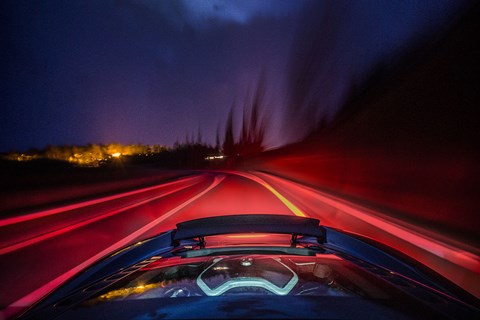► 24 hours with the McLaren 650S LM
► No stops, it’s time to drive all night
► It’s our 24-hour lap from la Sarthe
Circuit de la Sarthe, Le Mans: 1.14pm Saturday
I suppose when you won the world’s greatest motor race at the first attempt you acquire some clout but, even so, I’m not sure quite how McLaren has swung this one. In less than two hours’ time a waved tricolor will see the 83rd running of the 24 Heures du Mans get underway, and set in motion a compelling struggle for supremacy between Porsche and Audi. But first an armada of McLarens – a couple of P1s, a P1 GTR, two limited edition 650S Le Mans and a bewildering array of F1 GTRs – will run in a parade lap, on the full 8.4-mile circuit, with the chicanes removed from the Mulsanne, at a speed of test driver Chris Goodwin’s choosing. And I’ll be in it, driving one of the 650S LMs. The potential for infamy is extraordinary. The man who spun into an irreplaceable F1 GTR, carpet-bombed the Porsche curves with shards of historic carbonfibre and delayed the race start for 250,000 trackside spectators and a global TV audience would never be forgotten.
I’d be nervous if the scene in the holding area wasn’t so surreal. Yannick Dalmas, one third of the triumphant ’95 driver line-up together with Masanori Sekiya and JJ Lehto, sits impassively in the £1.98million, 986bhp hybrid P1 GTR, the car’s buttercup yellow paint ablaze beneath a fierce midday sun. Behind him, Derek Bell is cool at the wheel of the equally yellow Harrods F1 GTR, its featherweight carbonfibre doors cocked skyward. Where 20 years ago frantic pit crew would have been lodged headfirst in the open door apertures, today its autograph hunters. And up at the front, Chris Goodwin looks genuinely excited to be driving the Ueno Clinic car, the machine that came home first 20 years ago and cemented the McLaren F1’s status as the most remarkable supercar ever built.
‘We didn’t expect anything in ’95,’ says JJ Lehto, leaning casually against a ’97 Longtail, the car the F1 GTR morphed into when rivals lost sight of the spirit of the GT rulebook and instead stretched it to breaking point. ‘We just thought we’d do the best we could and see what happened. I remember feeling good though – it was the first time I’d been 100% after my big F1 accident in 1994. It took me a year and a half to recover. And I liked the car from the beginning. The central driving position made it feel like a single-seater and the engine was the best I’ve ever used: the noise, the responsiveness, the torque. Yes it rolled a little at the back in corners but I quite liked that.’
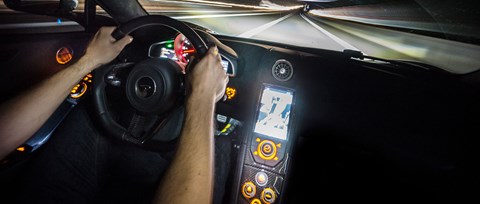
I joke that it’s very McLaren to have had a replica of his ’95 Ueno Clinic race-suit made for a single parade lap. ‘No, no, this is the original suit – I kept it,’ explains the enviably lean and youthful-looking Finn, deadpan.
The BMW V12 in Goodwin’s GTR shatters the silence and we scurry to our cars. Barriers are shifted, normally po-faced French marshals break into mile-wide smiles and suddenly we’re on the circuit. The next few minutes are manic, wonderful and exhilarating. Goodwin’s pace is more qualifying than pre-race parade, his F1 hustling through Tertre Rouge and slinging out onto the Mulsanne like he means business. In the 650S LM I’m trying to remember to breathe, working hard to enjoy the car and the moment without becoming that man. First impressions? The LM’s any-rev drive is handy when you don’t know where you’re going, as is the car’s prodigious front-end grip, and the carbon-ceramic brakes go from disinterested to mighty with a bit of heat.
As the race gets underway, I take my cue to leave. Perverse perhaps, but this car’s too intriguing to leave in a car park while I drink until I can speak fluent French. On the way out the LM gets more attention than you might expect of a relatively restrained supercar shape rendered almost invisible in metallic grey. The nods to the F1 GTR might be subtle – roof-top snorkel air intake, vented front wheelarches, five-spoke mag wheels (19in fronts; 20in rears), a smattering of exterior carbon (splitter, extended side-blades, airbrake, bigger diffuser) – but together they give the normally slightly amorphous 650S a more purposeful, undoubtedly F1-inspired silhouette. The production run of 50 cars, at £244,500 apiece, is sold out. Beneath the skin it’s business as usual: a 640bhp twin-turbo V8 and a performance-obsessed carbonfibre chassis 10kg lighter than the standard 650S coupe’s. And 24 hours to play with.
South of Clermont-Ferrand: 10.48pm Saturday
The wall of rain-laden cloud was waiting just south of Tours – a 1000ft wall of angry black cloud. As the 650S passed into it and the lights flicked on, we crossed from one world to another, from bright fields, easy miles and pretty sunsets to lagoons of standing water, the insistent pounding of rain on carbon roof and lip-chewing concentration. That was hours ago. It’s still raining.
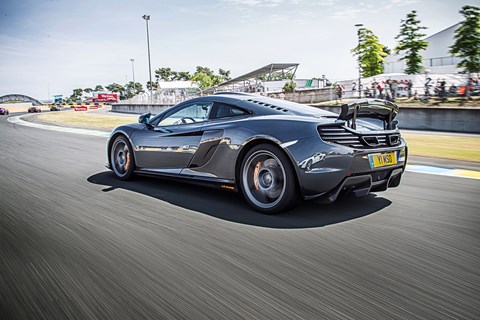
Back at Le Mans, Mark Webber’s on a quadruple stint in his Porsche 919. Bless him. I’m into my eighth hour, helped by a supercar cockpit so right you wonder why most everyone else gets it so wrong. Crucially, the seats are superb – slim, supportive, anatomically perfect and, splashed with orange to liven things up, pretty stylish. The pedals are beautiful – to look at and to use. Slightly offset admittedly, with a brake pedal that begs to get to know your left foot, but given the forces at their control, rightly serious and industrial in look and feel. The alcantara-rimmed wheel looks wrong, with its fat boss and flat bottom, but feels perfect. After its oddly egg-shaped rim, every subsequent wheel you hold feels chubby and nasty. Visibility, while not quite F1 good, is still widescreen enough to deliver some pretty panoramic views of both the world you’re charging towards and the one you’re leaving behind. Handy when you’re trying to slide into a tollbooth without wrecking a magnesium rim, or overtake a struggling Renault 5 without collecting it.
The steering itself is, in Sport, the chassis’ intermediate setting, a thing of wonder: light, with next to no self-centering effect, but beautifully direct and bright with feel. In Normal it’s too light and a little vague, but since the chassis settings come as a package, Sport steering means Sport suspension too. Even so the 650S LM rides with astonishing pliancy, gliding over lumpy motorway tarmac like a fat-tyred limousine. Cabin noise is nicely suppressed. Engine racket is little more than a murmur in seventh gear and, when you must change gear, the gearbox does so swiftly and smoothly, and with a delicious click of the one-piece casting that’s almost – almost – as rewarding as a gearlever. If there’s a slicker paddleshift gearbox, whether you’re battering the tacho’s red line in an unseemly hurry or slurring lazily around in automatic mode, I haven’t found it yet.
On the northern fringes of the Cevennes national park the motorway sheds lanes and get serious. The landscape, all monolithic rock faces and plunging gorges, closes in as the road weaves and climbs. I’m torn between cruising safely through the waterlogged curves and the need to crack on. The car makes the decision for me, feeling solid despite the conditions. I relax my grasp on the wheel, back the wiper off – rain streams from the screen’s dual-compound curves just fine without it – and trust the car, carving up the valley as the ever-ready V8 counters the gradient without so much as raising its voice. In a cabin almost silent bar the muffled roar of thousands of litres of displaced water and the insistent, increasingly manic chatter of my own exhausted thoughts, all is serene. A speed camera flashes. I go faster, trying to be more JJ.
‘In ’95 the rain in the night was really good for me,’ Lehto had told me earlier. ‘Over 24 hours you have the time to find the right line for the wet. You find the grip, the right gear and the rhythm, and it gets easier. I didn’t really push over the limit, I was driving comfortably, but the guys in the pits weren’t sure. They came over the radio saying, ‘you’re 30 seconds faster than everyone else – are you sure about this?’ I told them ‘I’m sure, don’t worry!’
Don’t worry.
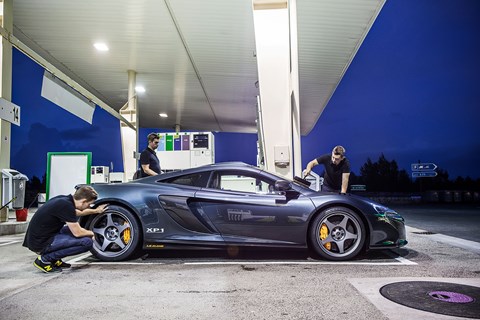
Somewhere on the N88: 6.49am Sunday
I don’t normally do this. I don’t normally drive like this. Maybe it’s my breakfast, a hallucinogenic blend of coffee milk and Haribo. Maybe it’s a product of the long hours of motorway-mile anticipation, spiked with fatigue. Whatever, the result is a hypnotic couple of hours on the most insanely sinuous N-roads, their endless corners running one into another over hundreds of kilometres of rugged, apparently unpopulated rural France. Any lingering doubts about the wisdom of swerving the race for this drive are gone.
Now the 650S LM feels nothing like the hushed, serenely suspended conveyance I climbed from just a few hours before. With the chassis and powertrain in Sport the car is taut, hair-trigger responsive – lag, if you’re in anything like the right gear, just isn’t a factor – and apparently without limits when it comes to the task of changing direction at speed. I brake as late as I dare, clock that big carbon airbake go vertical in the mirror, turn the wheel and somehow know that the McLaren will grip. Lean on its roll-free, grip-laden mid-corner poise and then decide how silly you want to be. Wait until the car’s straight before deploying the V8 and firing up to speed, or bring in the throttle early, ease off the lock as the electronics manage the wheelspin and the yaw angle, then disappear up the road convinced you’re a kind of late-blooming, slightly bigger-boned JJ Lehto, albeit one cruelly denied your big
acing break. The way in which the McLaren makes you comfortable with its towering potential – for railing around corners and for gaining and losing faintly ridiculous speeds – is mesmerising and terrifying in equal measure. At the Corniche des Cevennes the leash goes taut, the clock on the neat, ultra-crisp IRIS display urging a 180-degree change of direction and a return to Le Mans, perhaps in time to see the flag fall.
160km southeast of Le Mans: 11.53pm Sunday
Truly, tests of restraint come no sterner than this. The 650S LM and I are hurrying north along big, empty roads, the vast landscape’s rural tapestry broken only by the road and the occasional grain store the size of a cathedral. Traffic is sparse, visibility apparently limited only by the curvature of the earth and, after 24 hours, 1000 miles and less sleep than most Spaniards manage in a lunch hour, I’m shattered. North of Le Mans, when the faithful stream for the Channel ports in a couple of hours’ time, there won’t be the space to speed, nor any sense in doing so, given the police presence. But here we’ve the world to ourselves.
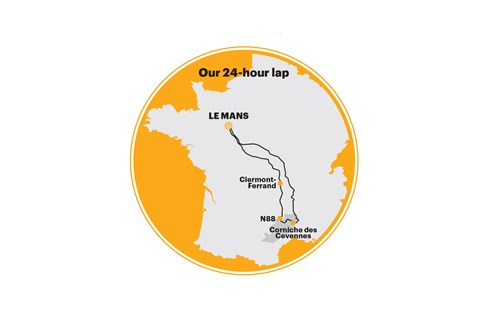
Drop the V8 into the foothills of its thick, unrelenting power curve. Push to the floor that exquisite alloy pedal. The crushing, insistent change of state you expect, surreal though it is with intangible turbo torque. The noise – a manic storm of induction roar, high-rev whine and mournful, fluttering turbos – you don’t. The LM’s carbonfibre snorkel effectively wires your brain to the bowels of the engine, a kind of sonic shortcut from inner ear to inlet tract. If you struggle with the standard 650S’s slightly cool, standoff-ish demeanour, the LM’s induction system is the cure. Overtaking, regardless of the number of cars to be passed, their speed or the space available, is as easy as breathing.
Circuit de la Sarthe, Le Mans: 4.27pm Sunday
The roads out are as packed as the roads in are desolate. A post-race high hangs over this most magical of circuits. In Porsche’s trucks Webber, Hulkenberg and friends are enjoying their first beer of the weekend and discussing how to make the 919 faster and stronger for 2016. In McLaren’s temporary MTC (a couple of admittedly very clean trucks and an awning; no lake), I find Lehto, set for the journey home. He’s bemused that I’ve entirely missed a thrilling Le Mans 24 hours but seems genuinely interested in the grimy, bug-smeared 650S LM.
‘I drove it for the first time coming here this weekend,’ he tells me. ‘I liked it. It’s very quiet, very civilised. You can drive the bumpy roads no problem, and when you start to drive faster you can stiffen up the suspension. Everything is so McLaren, so Ron: the graphics on the screen, the perfect stitching, the lovely steering wheel. And I like the engine. Nice car. Maybe McLaren would do me a price on one?’
For you JJ, I’m sure.

The 650S that thinks it’s an F1
Well done us
‘At McLaren Special Operations (MSO) we felt very strongly that we needed to do something to mark the 1995 victory, and what better way than a special edition 650S?’ says MSO’s James Banks. ‘We’re very close to the F1 – we worked on them then and we look after them still. The F1’s designer, Peter Stevens, was involved in the process, which took a year from start to finish. All the work was done in-house – we’re like a microcosm within McLaren, able to call on expertise in the wider business should we want to.’
Paint
Very, very grey, which either sets the orange calipers off nicely or makes the car far too subtle, depending on how much attention you received as a child. Banks: ‘With the colour, La Sarthe grey, we wanted to echo the livery of the Ueno Clinic car – it’s a visual average of that car’s two greys. Most of the 50 LMs are in the grey, with one in Harrods-inspired yellow and green and a couple in orange.’
Rooftop snorkel
‘We’d done one previously, as a one-off for a customer, so we’d done the groundwork,’ explains Banks. ‘It was a lot of work because it channels induction air; it’s not just cosmetic, or for cooling. It had to supply the right amount of air, to avoid over-spooling the turbos. We also worked to ensure its shape didn’t disrupt the boundary layer of air running over the car. It brings a little P1 to the 650S and more character.’
Wheels and brakes
‘We weren’t sure whether this kind of five-spoke design would work on the 650S but they look fantastic,’ says Banks. ‘I can’t claim it’s any lighter than the standard 650S wheels but they look right.’ The 650S LM features standard orange brake calipers. Choose P-Zero or track-ready P-Zero Corsa rubber.
Wheelarch vents
‘We tried a couple of options with the vents in the carbonfibre front wheelarches. We looked at a more upright louvre, like those of the ’97 F1 GTR, but settled on something more subtle inspired by the vents on the F1 LM. They help evacuate high-pressure air from the wheel wells, reducing lift.’
The specs
McLaren 650S Le Mans
Price: £244,500
Engine: 3799cc 32v twin-turbo V8, 641bhp @ 7500rpm, 500lb ft @ 6000rpm
Transmission: Seven-speed dual-clutch auto, rear-wheel drive
Suspension: Aluminium double wishbones front and rear
Performance: 3.0sec 0-62mph, 207mph, 24.2mpg (claimed), 19.2mpg (tested)
Length/width/height: 4512/2093/1224mm
Weight/made from: 1320kg (dry)/carbonfibre & aluminium
Rating: *****
